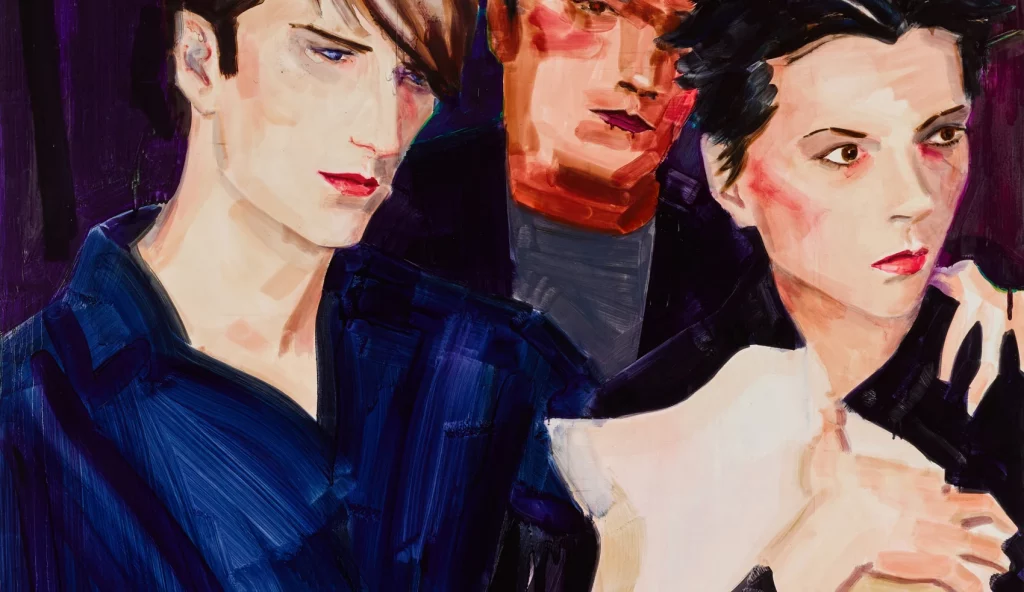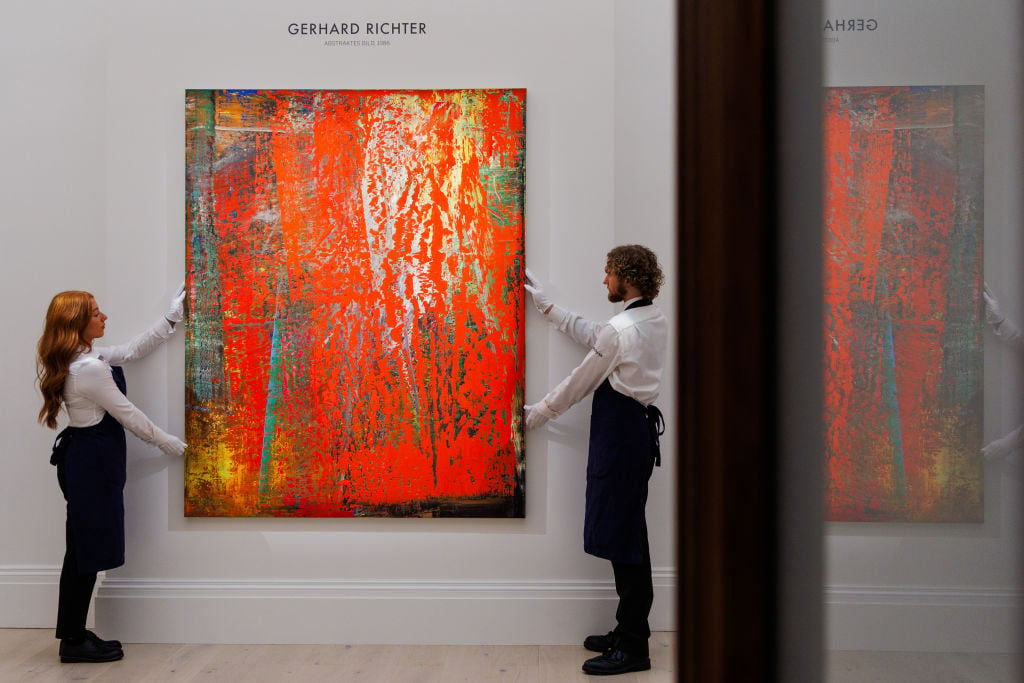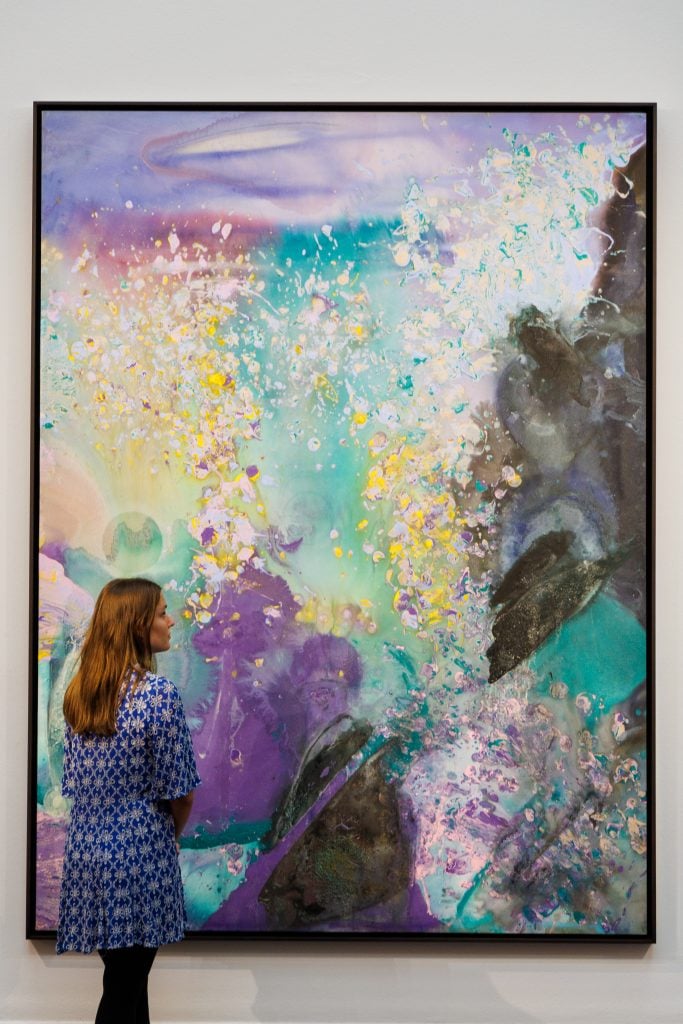Auctions
Two Back-to-Back Contemporary Auctions at Sotheby’s London Send Mixed Signals About the Art Market
The house's The Now sale outperformed its broader evening contemporary auction.

The house's The Now sale outperformed its broader evening contemporary auction.

Colin Gleadell

Frieze week contemporary art sales got off to an uncertain start on October 12 with two evening sales at Sotheby’s that told two different stories.
The more positive outcome was at The Now sale, the auction house’s fifth in the series, which was conceived to reflect demand for recent contemporary art. Estimated to net £9.4 million to £13.6 million for 21 lots, it realized £15.5 million ($19 million) with 15 lots sold within or above estimates and three artist records set. (All final totals given, unless otherwise noted, include auction house fees. Presale estimates do not.)
The relevant trajectory for this is that there were four more lots with a slightly higher presale estimate than last October, when the sale was pegged at £8.9 to £11.5 million. The total was 75 percent up from June, but still a long way down from the first Now sale in March 2022, when 22 lots with a low estimate of £18 million realized £30 million.
After some criticism last year about the “nowness” of the work on offer, Sotheby’s this year offered journalists a breakdown on recent prices for the artists, highlighting that their highest prices had been achieved in the last three to five years, thus qualifying for the sobriquet, at least as far as the market was concerned. The question became whether that demand was holding up.
Despite the sale title’s implications, two works were from the 20th century and had appeared on the block before. Marlene Dumas’s Spread (1999) was bought in 2003 for $141,900 (£85,200) and sold tonight for £483,000, without competition, to a third-party guarantor. Meanwhile, Elizabeth Peyton’s painting of the Beckhams, David, Victoria and Brooklyn (1999)—bought in 2001 for $94,000 (£65,700)—came to auction with a £1.2 million low estimate and sold for £1.7 million, realising a phenomenal 26.7 percent average annual growth in value over the period.

Elizabeth Peyton’s David, Victoria and Brooklyn (1999). Courtesy of Sotheby’s.
Adding to the work’s appeal was surely soccer star David Beckham’s growing popularity in the U.S., where he now plays, although Sotheby’s also pointed out that seven of Peyton’s top ten auction prices have been set in the last five years. That includes her record of $2.5 million, set last November at Sotheby’s New York for Nick With His Eyes Shut (2003), according to Artnet’s Price Database.
Another good return among the top lots was for Cecily Brown’s Tricky (2001), which was bought for £228,500 in 2007 by a British collector. Now, it yielded £2.6 million. Brown is currently enjoying a prestigious solo show at the Metropolitan Museum in New York.
The top lot was to have been Peter Doig’s contemplative By a River (2004) with an estimate of £3 million to £4 million, but it was withdrawn for lack of presale interest.
Notable records did tumble, however. Those included for Lynette Yiadom-Boakye’s six-and-a-half-foot portrait Six Birds in the Bush (2015), carrying her highest estimate yet at £1.2 million to £1.8 million, which cruised past that to hit £2.9 million ($3.6 million)—Sotheby’s proudly announced it as a record for any Black British woman artist—and Mohammed Sami, who only made his auction debut in March when he achieved £355,600 at Sotheby’s. The latest offering, Poor Folk 1 (2019), had likewise been bought from the Patrick Heide Gallery in London for around £15,000 and, estimated at £50,000 to £80,000, sold for £558,500 ($686,570). Sami is represented by Luhring Augustine in New York and Modern Art in London.
Other records in the Now sale fell for Pace Gallery’s William Monk (a double-estimate result of £266,700) and Matt Connors, whose colorful untitled abstract composition from 2015, last sold in 2016 in New York for $112,000, traded hands this time to Sotheby’s Hong Kong-based director Alex Branczik for a slightly improved $156,000.
Throughout the evening, competition from Asia was more restrained than usual and accounted for 20 percent of registrants, Sotheby’s said.
Making her auction debut was Stefanie Heinze, who shows with Pippy Houldsworth and Capitain Petzel, and whose surreal concoction Voyeurs’ Interfere (2016) carried an eye-opening £120,000-to-£180,000 estimate and sold for £279,400 to the same Asian phone bidder who bought the William Monk. The other debutant was Chinese artist Jiang Cheng, who has shown recently with Perrotin in Paris and Gagosian in Hong Kong, but whose portrait, Michael, was guaranteed by Sotheby’s and sold at the low estimate of £31,750 ($38,700).
Also guaranteed by Sotheby’s but unsold was Jordan Casteel’s painting of fellow Yale student Jonathan. On its last outing in 2019, the canvas sold for $326,000 at Christie’s; this time, with a covering estimate of £300,000 to £400,000, there were no bids at £220,000—so now it belongs to Sotheby’s.
The market held back on Jadé Fadojutumi’s large 2018 painting, Cradled, perhaps because of the estimate which was equal to highest yet for the rising artist at £400,000- £600,000, and while it sold, no one was prepared to compete with an in-room bidder who claimed it with a £390,000 offer.
An unusual loss was anticipated for a work by another rising artist, Issy Wood, whose 2020 Kinkstarter—a close-up oil on velvet of black and red leatherware—had returned to the block as part of a larger consignment from Asia, after selling at Christie’s New York in May 2022 for $478,000. But several bidders took it back to its previous level, offering £419,100 ($514,927) on a £150,000 low estimate, and maintaining a sense of equilibrium to finish out the Now sale.
The mood then shifted for Sotheby’s main contemporary sale, with its more forgiving chronological span. The auction was well-attended, attracting a crowd of U.S. dealers, advisors, and collectors who had been perusing the Frieze fair—Don and Mera Rubell, Christophe van der Weghe, Stellan Holm, and Kim Heirston among them. But they were largely inactive. The sale contained just 21 lots after five were withdrawn, and had a £39.9 million – £57.9 million presale estimate, a steep drop from last year’s £81.4 million-to-£106.5 million estimate (albeit for 34 lots).
The sale total of £30.2 million ($37 million) will not lend confidence to the market. Of the lots that sold, over half (11) did so either on the low estimate or below.

Gerhard Richter’s Abtraktes Bild (estimate £16 – 24 million), painted in 1986, goes on view as part of Sotheby’s Frieze week exhibitions of Contemporary art at Sotheby’s on October 06, 2023 in London, England. Photo by Tristan Fewings/Getty Images for Sotheby’s.
The highest estimate of the sale was the £16 million to £24 million for Gerhard Richter’s 1986 red Abstraktes Bild, which the house identified as “from a distinguished European collection,” which we understand is that of the Swiss billionaire financier Urs Schwarzenbach.
The painting was bought at Sotheby’s London in February 2003 near the top estimate for £766,600. Subsequently, Richter’s 1980s abstracts—executed with squeegee and exuding luxury and wealth—became highly sought after by the likes of Roman Abramovich, who drove prices up into the eight-figure bracket.
But Schwarzenbach’s work had perhaps the wrong association to attract bids. Last year, the financier was ordered to pay CHF160 million to Swiss tax authorities for avoiding import tariffs on artworks. Branczik was the only staffer on the phone for the Richter in question, but did not bid. Branczik had sold the last major Richter abstract at Sotheby’s in Hong Kong to a Chinese buyer.
The second-place lot by high estimate was a small Francis Bacon, Study for a Portrait (1979). It had been on the block as recently October 2020, when it was sold by Sotheby’s in Hong Kong for the equivalent of £3.95 million. Then it changed hands again before arriving in London with a £3.5 million low estimate and a third-party guarantee. This time Branczik did pull the trigger for his client, presumably the guarantor, on the low estimate for £4.3 million ($5.3 million), the highest price of the evening.
Another swift turnaround that defied expectations was for a Yayoi Kusama pumpkin sculpture that was acquired by an Asian buyer in New York in 2020 for $2.2 million. It was up again with a £2.4 million low estimate and a third-party guarantee, which it just surpassed, selling to an in-room bidder for £3 million ($3.66 million).

Frank Bowling’s Moby Dick (estimate £700,000 – £1 million), Photo by Tristan Fewings/Getty Images for Sotheby’s.
Heading for a record and without a guarantee was Frank Bowling’s sizable Moby Dick (1981), with the highest estimate ever for the artist, £700,000 to £1 million. In line with asking prices for his best works at Hauser & Wirth since they took over management of his affairs from Hales gallery, it sold, but did not take off. A bidder paid £762,000 ($930,000)—a record, nonetheless.
The most positive results in this sale were a double-estimate £3.3 million ($4 million) for Andy Warhol’s pink-and-black Diamond Dust Shoes (1980) and a wall hanging, Dexterity (2021), by Ghanaian artist El Anatsui, which flew over estimate to an in-room bidder for £1 million ($1.22 million).
The bargain of the sale was probably an untitled streetlamp sculpture by Martin Kippenberger, which was estimated at £600,000 to £800,000 and sold to Martin Klosterfelde, a director at Per Skarstedt, for £495,500 ($604,000).
Identifiable pricing gains were made for older generation artists such as Georg Baselitz, Donald Judd, and Philip Guston, but not huge amounts considering their holding periods. Other American stalwarts such as Pat Steir and Robert Ryman sold at a loss compared to previous prices at auction, underscoring that this is a market in the throes of adjustment.
More Trending Stories: